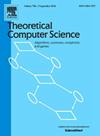联集-交集-有界族的算法构造
IF 0.9
4区 计算机科学
Q3 COMPUTER SCIENCE, THEORY & METHODS
引用次数: 0
摘要
在本文中,我们提出了联合-交集有界集合族的下界和算法构造。下界是利用洛瓦兹局部定理(Lovász Local Lemma)建立的。这个下界与已知的联合交集有界集合族大小的最佳下界相吻合。然后,我们使用 Lovász 局部定理的变量框架,讨论一种算法,它能输出达到下界的明确构造。该算法的复杂度为族中点数的多项式。本文章由计算机程序翻译,如有差异,请以英文原文为准。
An algorithmic construction of union-intersection-bounded families
In this paper, we present lower bounds and algorithmic constructions of union-intersection-bounded families of sets. The lower bound is established using the Lovász Local Lemma. This bound matches the best known bound for the size of union-intersection-bounded families of sets. We then use the variable framework for the Lovász Local Lemma, to discuss an algorithm that outputs explicit constructions that attain the lower bound. The algorithm has polynomial complexity in the number of points in the family.
求助全文
通过发布文献求助,成功后即可免费获取论文全文。
去求助
来源期刊

Theoretical Computer Science
工程技术-计算机:理论方法
CiteScore
2.60
自引率
18.20%
发文量
471
审稿时长
12.6 months
期刊介绍:
Theoretical Computer Science is mathematical and abstract in spirit, but it derives its motivation from practical and everyday computation. Its aim is to understand the nature of computation and, as a consequence of this understanding, provide more efficient methodologies. All papers introducing or studying mathematical, logic and formal concepts and methods are welcome, provided that their motivation is clearly drawn from the field of computing.
 求助内容:
求助内容: 应助结果提醒方式:
应助结果提醒方式:


